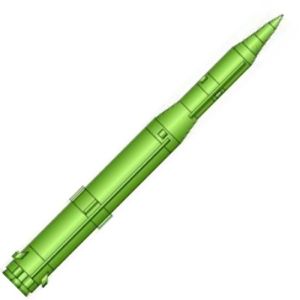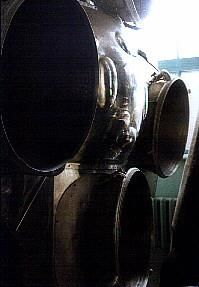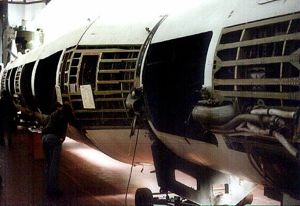
Home - Search - Browse - Alphabetic Index: 0- 1- 2- 3- 4- 5- 6- 7- 8- 9
A- B- C- D- E- F- G- H- I- J- K- L- M- N- O- P- Q- R- S- T- U- V- W- X- Y- Z
UR-200
 UR-200 launch Credit: © Mark Wade |
AKA: 8K81;Sheksna-V;Sheksnva-V;SS-10. Status: Retired 1964. First Launch: 1963-11-05. Last Launch: 1964-10-20. Number: 9 . Payload: 2,000 kg (4,400 lb). Thrust: 1,998.69 kN (449,323 lbf). Gross mass: 135,710 kg (299,180 lb). Height: 34.65 m (113.68 ft). Diameter: 3.00 m (9.80 ft). Span: 4.20 m (13.70 ft). Apogee: 185 km (114 mi).
Unofficially Chelomei began work on what would become the UR-200 in 1960. An exhaustive trade study was made of payload and orbital requirements and alternate launch vehicle configurations. On 16 March and 1 August 1961 the Central Committee and Politburo approved development of the UR-200 (8K81) universal rocket. The UR-200 was designed not only to send a thermonuclear warhead over a range of 12,000 km, but also to orbit the IS (Istrebitel Sputnik) ASAT; the US (Upravlenniye Sputnik) nuclear-powered naval intelligence satellite; and the AB-200 combat re-entry vehicle, which would use aerodynamic horizontal and vertical maneuvering to penetrate enemy space defenses and be practically invulnerable. The UR-200 draft project was completed in July 1962. Pilyugin would build the rocket's inertial navigation system. The missile's technical characteristics would be similar to those of Korolev's R-9A and Yangel's R-16. The ICBM version was designed to be launched from the same Sheksna-V launch silo complex designed for the R-16. The thermonuclear warhead was designed by B V Litvinov at Chelyabinsk-70.
Launch complexes LC-90 and LC-92 were built at Baikonur was according to the design of OKB-52 Filial 2 (later GNIP OKB Vympel). Nine trial flights of the ICBM version from those sites ran from 4 November 1963 to 20 October 1964.
On October 13, 1964, Khrushchev was ousted from power. The new leadership, under Brezhnev, was adverse to all projects Khrushchev had supported. These included those of Chelomei and his OKB-52. An expert commission under M V Keldysh was directed to examine all of Chelomei's projects and make recommendations as to which should be cancelled. Keldysh found that Yangel's R-36 ICBM could be modified to cover the universal rocket missions of Chelomei's UR-200. The UR-200 and AB-200 were accordingly cancelled, while the IS and US satellites were redesigned for launch by the R-36.
Originally the UR-200 was to be a building block for Chelomei's UR-500 space launcher, with five UR-200's being clustered together. However as design studies of the UR-500 progressed, this approach was abandoned in favor of a 'polyblock' approach. However the UR-200 lived on in the two upper stages of the UR-500, which were essentially repackaged, larger-diameter versions of the UR-200's two stages. In that form the design enjoyed great commercial success and continued in service into the next millennium.
The UR-200 remained completely unknown to the Western public until the 1990's. The CIA, monitoring the missile's flight tests, had assigned the designation SS-10 to the missile. When Korolev's cancelled GR-1was paraded in Moscow on 9 May 1965, it received the ASCC reporting name 'Scrag'. Western Soviet observers conflated the two rockets together into the 'SS-10 Scrag', and believed that this was used to launch the FOBS orbiting nuclear warheads actually launched by Yangel's R-36-O. Thus were three competing missiles rolled into one non-existent rocket in the minds of Western observers. UR-200 artifacts may be found at the following museums: Tsniimash has a 1:10 structural simulation model; Orevo has a complete sectioned missile; Baikonur has models and launch photographs.
LEO Payload: 2,000 kg (4,400 lb) to a 185 km orbit at 52.00 degrees. Standard warhead: 2,683 kg (5,915 lb). Maximum range: 12,000 km (7,000 mi). Number Standard Warheads: 1. Warhead yield: 5,000 KT. Alternate warhead: 3,900 kg (8,500 lb). Maximum range with alternate warhead: 10,000 km (6,000 mi). Number Alternate Warheads: 1. Alternate warhead yield: 15,000 KT. Total Number Built: 9.
Stage Data - UR-200
- Stage 1. 1 x UR-200 Stage 1. Gross Mass: 107,500 kg (236,900 lb). Empty Mass: 6,600 kg (14,500 lb). Thrust (vac): 2,235.000 kN (502,447 lbf). Isp: 311 sec. Burn time: 135 sec. Isp(sl): 278 sec. Diameter: 3.00 m (9.80 ft). Span: 3.00 m (9.80 ft). Length: 20.00 m (65.00 ft). Propellants: N2O4/UDMH. No Engines: 1. Engine: RD-0202. Other designations: 8K81 Stage 1. Status: Out of production. Comments: Tsniimash has 1:10 structural simulation model. Developed 1960-1965. Orevo has sectioned hardware. All data accurate except empty mass prorated between first and second stages.
- Stage 2. 1 x UR-200 Stage 2. Gross Mass: 25,810 kg (56,900 lb). Empty Mass: 2,400 kg (5,200 lb). Thrust (vac): 612.900 kN (137,785 lbf). Isp: 322 sec. Burn time: 113 sec. Diameter: 2.20 m (7.20 ft). Span: 2.20 m (7.20 ft). Length: 10.00 m (32.00 ft). Propellants: N2O4/UDMH. No Engines: 1. Engine: RD-0205. Other designations: 8K81 Stage 2. Status: Out of production. Comments: Tsniimash has 1:10 structural simulation model. Developed 1960-1965. Orevo has sectioned hardware. All data accurate except empty mass prorated between first and second stages.
| UR-200A Russian intercontinental boost-glide missile. Version that would boost the Raketoplan combat re-entry vehicle, which would use aerodynamic horizontal and vertical maneuvering to penetrate enemy space defenses and be practically invulnerable. |
| UR-200B Russian orbital missile. Global rocket version. Would place nuclear warhead into orbit, which would approach United States from any direction at low altitude and be deorbited with little warning time on enemy targets. |
Family: ICBM, silo-launched. Country: Russia. Engines: RD-0205, RD-0202. Spacecraft: Raketoplan, Kosmoplan, US-A. Launch Sites: Baikonur, Baikonur LC90/19, Baikonur LC90/20. Stages: UR-200-2, Proton K-2. Agency: Chelomei bureau. Bibliography: 193, 194, 2, 220, 273, 474, 475, 476, 8746.
 | 8K81 Model Credit: © Mark Wade |
 | UR-100 UR-100 / 8K84 Missile with sealed transport/launch container Credit: © Mark Wade |
 | UR-200 ICBM UR-200 Universal Rocket, planned for both ICBM and space launch duties. Credit: © Mark Wade |
 | RD-0205 8D46 RD-0205 8D46 on stage 8S816 (UR-200) Credit: © Mark Wade |
 | UR-200 ICBM Drawing of UR-200 ICBM. The UR-200 was tested but not put into service. Credit: © Mark Wade |
 | UR-200 engine Credit: © Mark Wade |
 | UR-200 forward Credit: © Mark Wade |
 | UR-200 UR-200 based on launch photo Credit: © Mark Wade |
April 1960 - . Launch Vehicle: UR-200.
- Chelomei plan for Organic Space System. - .
Nation: Russia.
Related Persons: Chelomei,
Dementiev,
Khrushchev,
Myasishchev.
Spacecraft: Raketoplan.
Chelomei visits Khrushchev in the Crimea and presents his ambitious plan for an Organic Space System - a space infrastructure serviced by an integrated family of launch vehicles and spacecraft. The system would include orbiting stations, space factories, winged rockets, and nuclear weapons stored in space with plenty of decoys to defeat any enemy counter-measures. UR-200 rockets would fulfil all roles in servicing this array of weapons. Dementiev supported Chelomei's proposals, but the chief designer would need a factory to support fabrication of the rockets and spacecraft. Myasishchev's bureau and its associated Khrunichev factory were an obvious choice, since the decision had been taken not to put the M-50 bomber or Buran cruise missile into production and the factory would soon be idle.
1960 June 23 - . Launch Vehicle: UR-200.
- Chelomei Raketoplan, UR-200 ICBM, and IS antisatellite system authorised. - . Nation: Russia. Spacecraft: IS-A, Raketoplan. Decree 715-295 'On approval of preliminary work on the Raketoplan, UR-200 ICBM, and IS anti-satellite system' was issued..
1960 October 3 - . Launch Vehicle: UR-200.
- Chelomei acquires Myasishchev and Khrunichev OKBs. - .
Nation: Russia.
Related Persons: Chelomei,
Myasishchev.
Spacecraft: Raketoplan.
Central Committee of the Communist Party and Council of Soviet Ministers Decree 1057-434 'On transfer of OKB-23 as Branch No. I of OKB-52 and on course of work on IS anti-satellite system' was issued. Chelomei acquired the OKB-23 of Vladimir Mikhailovich Myasishchev, (which had formerly designed heavy bombers), as well as the M K Khrunichev heavy aviation factory. Both of these organisations had a very high level of technical and manufacturing expertise, and assisted Chelomei in quickly moving ahead on his new space projects.
1961 March 6 - . Launch Vehicle: UR-200.
- US RORSAT authorised. - . Nation: Russia. Spacecraft Bus: Kosmoplan. Spacecraft: US-A. Decree 420·1741 'On approval of work on the US satellite and UR-200 launch vehicle / ICBM' was issued..
1961 March 16 - . Launch Vehicle: UR-200.
- UR-200 (8K81) launch vehicle development authorised. - .
Nation: Russia.
Spacecraft: IS-A,
Kosmoplan,
OGCh,
US-A,
US-P.
An enabling decree was issued on 1 August 1961 by the Central Committee and Politburo. The UR-200 was designed not only to send a thermonuclear warhead over a range of 12,000 km, but also to orbit all of the Kosmoplan military variants: the IS ASAT; the US nuclear-powered naval intelligence satellite; and the Kosmoplan combat re-entry vehicle.
1961 August - . Launch Vehicle: UR-200.
- UR-200 universal ICBM / space booster authorised. - . Nation: Russia. Central Committee of the Communist Party and Council of Soviet Ministers Decree 'On course of work on the UR-200 missile and launcher' was issued..
1962 June 3 - . Launch Vehicle: UR-200.
- US RORSAT development plans. - . Nation: Russia. Spacecraft Bus: Kosmoplan. Spacecraft: US-A. Decree 'On course of work on the US reconnaissance satellite system launched on the UR-2OO' was issued..
1962 July - . Launch Vehicle: UR-200.
- Kosmoplan and UR-200 draft projects completed. - . Nation: Russia. Spacecraft: IS-A, Kosmoplan, US-A. Trial flights of the ICBM version ran from 4 November 1963 to 20 October 1964. Versions of the Kosmoplan would fly as the reactor-powered US-A and solar-powered US-P ELINT satellites and the I2P ASAT..
1962 July 15 - . Launch Vehicle: UR-200.
- UR-200 draft project is completed. - . Nation: Russia. Manufacturer: Chelomei bureau.
1963 November 5 - . Launch Site: Baikonur. Launch Complex: Baikonur LC90/19. Launch Vehicle: UR-200. FAILURE: Failure.
- State trials missile test - . Nation: Russia. Agency: RVSN. Apogee: 0 km (0 mi). First UR-200 test flight. (LKI).
1964 April 11 - . 07:05 GMT - . Launch Site: Baikonur. Launch Complex: Baikonur LC90/19. Launch Vehicle: UR-200. FAILURE: Failure.
1964 May 15 - . 06:56 GMT - . Launch Site: Baikonur. Launch Complex: Baikonur LC90/19. Launch Vehicle: UR-200.
1964 May 30 - . 04:02 GMT - . Launch Site: Baikonur. Launch Complex: Baikonur LC90/19. Launch Vehicle: UR-200.
1964 June 17 - . 04:00 GMT - . Launch Site: Baikonur. Launch Complex: Baikonur LC90/19. Launch Vehicle: UR-200.
1964 August 1 - . 05:54 GMT - . Launch Site: Baikonur. Launch Complex: Baikonur LC90/19. Launch Vehicle: UR-200.
1964 September 24 - . 05:56 GMT - . Launch Site: Baikonur. Launch Complex: Baikonur LC90/20. Launch Vehicle: UR-200.
- State trials missile test - . Nation: Russia. Agency: RVSN. Apogee: 686 km (426 mi). Demonstration launch witnessed by Khrushchev..
1964 October 2 - . 03:35 GMT - . Launch Site: Baikonur. Launch Complex: Baikonur LC90/20. Launch Vehicle: UR-200.
1964 October 20 - . 02:29 GMT - . Launch Site: Baikonur. Launch Complex: Baikonur LC90/20. Launch Vehicle: UR-200.
Back to top of page
Home - Search - Browse - Alphabetic Index: 0- 1- 2- 3- 4- 5- 6- 7- 8- 9
A- B- C- D- E- F- G- H- I- J- K- L- M- N- O- P- Q- R- S- T- U- V- W- X- Y- Z
© 1997-2019 Mark Wade - Contact
© / Conditions for Use